In Mehreen Murtaza’s installation, science is stranger than fiction; in a world where humans and plants can communicate, how will you conduct yourself in the company of trees?
Mehreen Murtaza How Will You Conduct Yourself in the Company of Trees? 2017 © Manchester Art Gallery
In Gallery 2, plants are everywhere, lit upwardly and casting elongated shadows onto the walls. Strange sounds fill the room from speakers that look like rocks, playing live music by plants that use synthesizers to translate their signals into sound. As you walk the heart-shaped wooden path that leads you around the room, you notice a cabinet of fungus samples from the Manchester Museum as well as a video of two slugs mating in a tree. Are the plants really trying to communicate with us? Is that even plausible? Is this science fact or science fiction? Could technology be used to break the language barrier between us and the world around us? These are all questions that Murtaza wants you to consider.
Debate about the environment has become increasingly important in the last decade, but pushing those ideas into the realm of science fiction and imagining better possible futures is firmly the territory of the 1960’s. This was the optimistic post-war boom of Modernism, Keynesian economics, the space race and a sense of progress. For those who didn't experience that decade first hand, these ideas have been reduced to the lowest common denominator. As memory of that time fades, the ideas simplify down to symbols that fit the narrative of history, or that make a good t-shirt. Many would look at the logo of the Campaign for Nuclear Disarmament and the only association to draw would be 'Peace, Man!'. This can be a distraction from the important discussions that took over culture so urgently then: environmental awareness, human rights, political activism and expanding your own consciousness.
51 years on from its 1966 debut and around the same time this installation opened, one of the most enduring optimistic visions of the future returned: Star Trek. On board the SS Discovery Lieutenant Stamets wishes he could talk to his mushrooms. He has been using a hardy fungus that can survive in space to create a new engine, one that lets the ship travel anywhere in the universe instantly. It does this using a giant creature called the tardigrade that can connect to the fungi's roots which span all of space in all dimensions. This may sound like the weirder end of the science fiction spectrum, however the facts they are based on are just as surprising. Lt. Stamets is named after Paul Stamets, an American mycologist who studies fungi and explores their untapped potential. He hasn't found evidence of an interstellar fungal system, but has found that forests can use giant fungi to communicate, sending necessary food and oxygen to each other. The Tardigrade is in fact a microscopic organism. In the show as in real life, both can survive in space and dehydrate their entire body, surviving decades without water or food. Fictional Stamets also claims his DNA is so similar to the fungi’s he should be able to connect to it himself. While this is a stretch, fungi have more similarities with our DNA than they do with plants. All of these ideas are present in Murtaza’s world too, represented here by her fungi samples. They ask us to think about how much we share with the natural world, the possibilities of organic communication and the strangeness of nature. This goes to show that the line between science fact and science fiction is not often clear, a concept that underpins the whole installation; the relationship between the worlds of science and imagination and how hard it can be to tell the difference.
from preview of Star Trek: Discovery episode 9 © 2006-2017 SciFanatic Network


